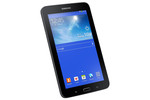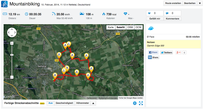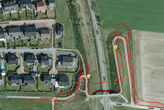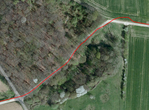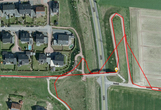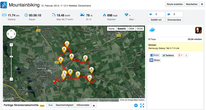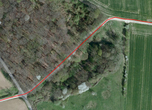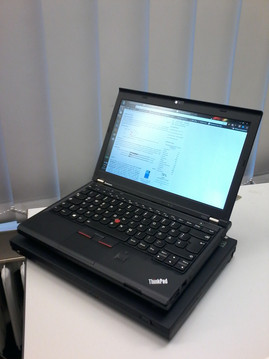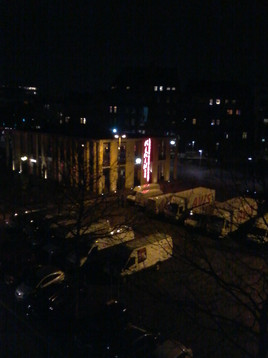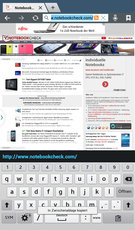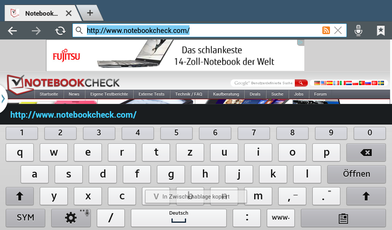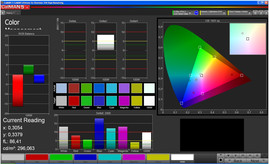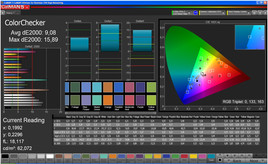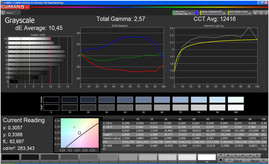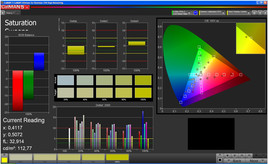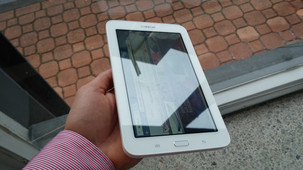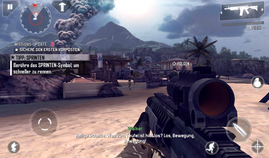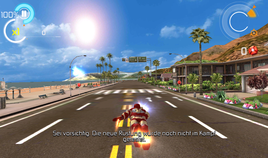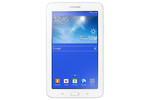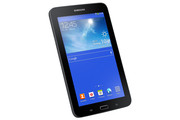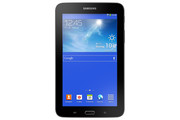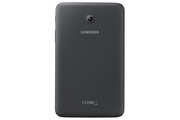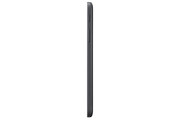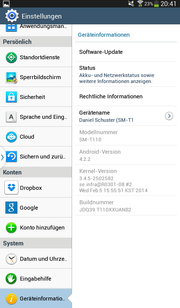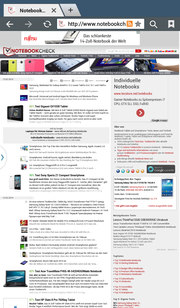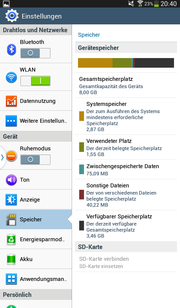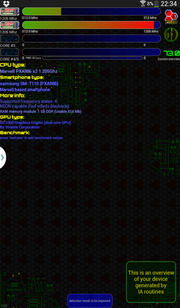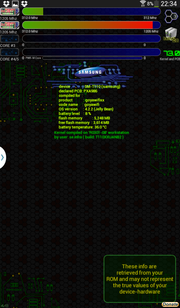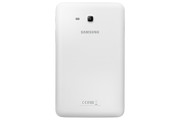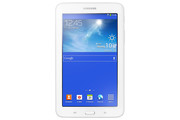Review Update Samsung Galaxy Tab 3 7.0 Lite Tablet
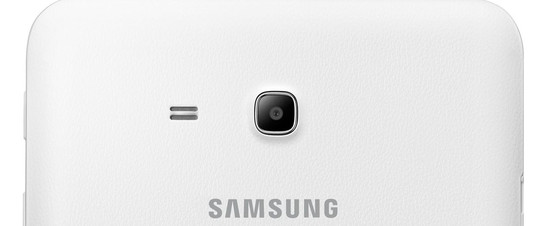
For the original German review, see here.
Samsung apparently feels the urge to launch new models on the market at least once a year. We often question just how much sense that makes. This is presently expressed in the South Korean manufacturer's latest "accomplishment" - the Galaxy Tab 3.0 Lite. The tag "Lite" suggests that the precursor has been put on a radical diet. However, those who have read the review of the Galaxy Tab 3 7.0 will know that there was not much room for cutbacks. Thus, we were all the more curious about what we could expect in the test period.
It seems reasonable to assume that some improvements have been made in dimensions. However, this is not the case, and sooner the opposite. The Tab 3 7.0 (188 x 111.1 x 9.9 mm) is slim in contrast to the Lite version's 193.4 x 116.4 x 9.7 mm. There is solely a minimal difference of 0.2 mm in thickness. That is so negligibly small that it is barely noticed in routine use. The same is true for the weight: Our review sample has gained 10 grams compared with last year's model.
So we ask ourselves where the "Lite" approaches are hidden. We soon realize that Samsung has managed to lessen the material quality even more. The Tab 3 7.0 Lite has absolutely nothing in common with the high-quality plastic of, for example, the Galaxy Note 3. The feel comes too short. The brushed aluminum look of the casing's edge has also fallen victim of the cutbacks. The device is nevertheless solid and rigid.
Connectivity
Nothing has been modified here, and all ports are roughly in the same place.
Software
We noticed a progress in the Android software version. The Tab 3 7.0 Lite is now powered by Android 4.2. Of course, Samsung overlays the Android interface with its launcher TouchWiz, and it is not stingy with bloatware.
Communication & GPS
The Wi-Fi module unfortunately does not use the dual-band mode, and it only transmits using the 802.11 b/g/n standard. The quality is nevertheless sufficient, and we did not notice any interruptions. Bluetooth version 4.0 is also installed, but there is no option of a Lite model with WWAN module.
The GPS module exhibits a fairly high accuracy, even when compared with the Garmin Edge 500 reference device. We have seen much worse GPS modules in the past.
Cameras & Multimedia
The term "Lite" finds use in the full sense of the meaning in this section. The manufacturer does not install the two weak camera modules used in the precursor. It takes a different approach, and completely omits the front-facing camera and reduces the megapixel count of the primary camera from 3 to 2 MP.
We would not dream of prettying up the results. Samsung has reduced the picture quality a notch here. This is seen in the lower sharpening and too dark pictures.
Accessories & Warranty
The included accessories are limited to a modular power supply and printed manuals. The review sample follows its precursor in terms of both accessories and warranty (24-month warranty period).
Input Devices & Controls
The capacitive touchscreen responds to inputs made by up to five fingers at the same time. The inputs are implemented accurately and quickly most of the time. We did not ascertain any differences in the accuracy of the older and newer model. Fortunately, Samsung restrained from omitting the physical home button. We still deem a separate navigation bar a big advantage over other devices because the space on the screen is not "lost."
Display
Apart from the screen size of 7-inches, and the low resolution of 1024x600 pixels, the precursor and successor do not have much in common. The Tab 3 7.0's average screen brightness of 426.6 cd/m² is much higher than the 269.2 cd/m² of our review sample. The same problem is seen in the illumination that is on an unsatisfactory level of only just 80%. The sole improvement is found in the black level of 0.62 cd/m². However, that is not low enough to achieve a better contrast than the precursor (548:1).
| |||||||||||||||||||||||||
Brightness Distribution: 80 %
Center on Battery: 301 cd/m²
Contrast: 485:1 (Black: 0.62 cd/m²)
ΔE ColorChecker Calman: 9.08 | ∀{0.5-29.43 Ø4.82}
ΔE Greyscale Calman: 10.45 | ∀{0.09-98 Ø5.1}
Gamma: 2.57
CCT: 12416 K
The Tab 3 7.0's bluish cast was reproached multiple times. The Lite version also struggles with this issue, but not to the same extent. The shifts in color temperature are noticed most adversely because the IST rate continuously deviates from the target rate with increasing brightness.
Middling brightness and middling contrast rarely lead to a good outcome in this section. The Tab 3 7.0's result was not awe-inspiring, and it looks even worse for the successor. It should be used mainly indoors.
Performance
The PXA986 from Marvell still operates inside. This dual-core clocks with a frequency of 1.2 GHz per core, and uses a working memory of 1 GB. Since there is no nominal difference to the precursor, the benchmark scores should be similar. Of course, we checked this anyway.
There is barely a noticeable difference between the Tab 3 7.0 and the present model in either the synthetic or browser-based benchmarks. Nevertheless, it becomes obvious that neither model stands a chance against the competition. Buying this device should be carefully considered at this point should performance be decisive for purchase.
| 3DMark - 1920x1080 Ice Storm Extreme Score (sort by value) | |
| Samsung Galaxy Tab 3 7.0 Lite | |
| Google Nexus 7 2013 | |
| Apple iPad mini Retina | |
| Palit Galapad 7 | |
| Asus Memo Pad HD 7 | |
| Geekbench 2 - 32 Bit - Total Score (sort by value) | |
| Samsung Galaxy Tab 3 7.0 Lite | |
| Samsung Galaxy Tab 3 7.0 inch | |
| Google Nexus 7 2013 | |
| Amazon Kindle Fire HDX 7 inch | |
| Palit Galapad 7 | |
| Asus Memo Pad HD 7 | |
| PassMark PerformanceTest Mobile V1 - System (sort by value) | |
| Samsung Galaxy Tab 3 7.0 Lite | |
| Samsung Galaxy Tab 3 7.0 inch | |
| Google Nexus 7 2013 | |
| Apple iPad mini Retina | |
| Palit Galapad 7 | |
| Asus Memo Pad HD 7 | |
| Browsermark - --- (sort by value) | |
| Samsung Galaxy Tab 3 7.0 Lite | |
| Google Nexus 7 2013 | |
| Amazon Kindle Fire HDX 7 inch | |
| Apple iPad mini Retina | |
| Palit Galapad 7 | |
| Asus Memo Pad HD 7 | |
| Peacekeeper - --- (sort by value) | |
| Samsung Galaxy Tab 3 7.0 Lite | |
| Samsung Galaxy Tab 3 7.0 inch | |
| Google Nexus 7 2013 | |
| Amazon Kindle Fire HDX 7 inch | |
| Apple iPad mini Retina | |
| Palit Galapad 7 | |
| Asus Memo Pad HD 7 | |
A step backward in performance can be seen in the form of the installed flash storage. The Lite version achieves a poor to very poor score. Only the Palit Galapad 7 stands out with even worse data rates in two of four benchmarks.
Games & Videos
Like in the numerous benchmarks, our nerves were again put to the test because many games are too demanding for the GPU, and lead to crashes. Iron Man 3 and Modern Combat 4 first started after several attempts. Though the system's weak performance was noticed, the games mostly ran smoothly.
Playing Full HD videos is not a matter of course for entry-level tablets. Fortunately, the Tab 3.0 7.0 Lite can deal with this challenge. We did not notice any artifacts or other loading delays.
Emissions
Temperature
We finally have some good news: Samsung has managed to reduce the review sample's average temperature. It only surpasses 30 °C slightly during load. We measured these temperatures on the precursor in idle. We ascertained rates between 26.7 °C and 27.1 °C when the SoC was idling. We measured a maximum of 44.9 °C on the power supply.
(±) The maximum temperature on the upper side is 40 °C / 104 F, compared to the average of 33.7 °C / 93 F, ranging from 20.7 to 53.2 °C for the class Tablet.
(+) The bottom heats up to a maximum of 38.4 °C / 101 F, compared to the average of 33.2 °C / 92 F
(+) In idle usage, the average temperature for the upper side is 27.1 °C / 81 F, compared to the device average of 30 °C / 86 F.
Speakers
The mono speaker is on the back of this model. Consequently, the sound is clearly falsified when the tablet is placed on an even surface. The speaker struggles with distortions and a tinny sound. Although it is sufficient for short music "enjoyment," the option of connecting external speakers should be considered.
Energy Management
Power Consumption
The power consumption is mostly on par with that of the Tab 3 7.0. Although the present review sample consumes a bit more power when idling (0.8 to 2.6 watts), the precursor consumed as much as 5.9 to 6.2 watts during load. This difference is mainly due to the brighter screen.
| Off / Standby | |
| Idle | |
| Load |
|
Key:
min: | |
Battery Runtime
The battery runtimes of both devices barely differ. The most significant difference that leads to the present device's better runtime is its darker screen. This is particularly noticed in the virtually identical results of both the idle and Wi-Fi scenarios. The screens are set to maximum brightness in full load - and thus the difference.
Verdict
Samsung does not simply revamp the Galaxy 3 7.0 Lite. The good trait of the Tab 3 7.0 precursor, the bright screen, has been rationalized and replaced with an inferior hardware part. Just as striking is the material's lower quality. Samsung, as an advocate of plastic casings, is quite able to achieve a better feel. The performance of both devices barely differs, which is not surprising because the same SoC from Marvell with a clock rate of 1.2 GHz is installed.
We cannot give the Galaxy Tab 3 7.0 Lite a purchase recommendation. We devalue the tablet via the "Impression" rating due to its middling overall impression. The manufacturer's RRP is currently 159 Euros (~$218); the precursor is already available for approximately 130 Euros (~$178). Thus, buyers who want a 7-inch entry-level tablet from Samsung should opt for the Tab 3 7.0. We would also recommend being noncommittal because there are "plenty more fish in the sea": The precursor of the Nexus 7 2013 or the Memo Pad HD 7 from Asus would be good alternatives.




